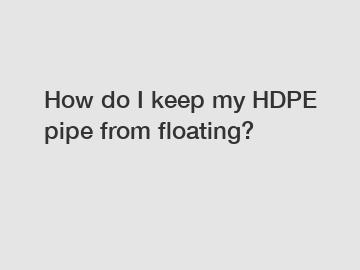Jan. 23, 2024
Rubber & Plastics
If you want to learn more, please visit our website Valor Pipe.
How Do I Keep My HDPE Pipe from Floating?
When it comes to installing HDPE (high-density polyethylene) pipes, one of the common concerns that arise is the pipe's tendency to float. Floating pipes can cause a range of issues, including compromised performance, difficulty in maintenance, and increased risk of damage. However, there are strategies and techniques that can effectively prevent HDPE pipes from floating. In this article, we will explore some of the best methods to keep HDPE pipes securely in place.

Proper Backfilling.
One of the primary reasons why HDPE pipes float is inadequate backfilling during installation. Insufficient compaction and improper soil placement can create voids around the pipe, allowing it to displace and float. To avoid this, it is crucial to ensure proper backfilling techniques. This includes using well-graded granular material for backfilling and compacting it layer by layer, paying close attention to achieving the right compaction density.
Anchor Systems.
Another effective solution to prevent HDPE pipe floating is the use of anchor systems. These systems provide additional stability by securing the pipe to the ground. There are various types of anchor systems available, such as concrete weights, helical anchors, and earth augers. The choice of anchor system depends on factors such as soil conditions, pipe diameter, and installation requirements. Consulting with experts in the field is recommended to determine the most suitable anchor system for your specific project.
Ballast Fill.
Ballast fill is another technique used to address floating HDPE pipes. This involves the use of heavy materials that add weight to the pipe and counteract buoyancy. Commonly used materials for ballast fill include concrete, sand, or gravel. Ballast fill is typically placed around and on top of the pipe, providing downward force and preventing flotation. Careful consideration must be given to the quality of the ballast material to avoid potential issues such as chemical reactions or degradation over time.
Concrete Collars.
Concrete collars offer an effective solution for preventing HDPE pipe floatation. These collars are installed around the pipe at specific intervals and provide additional weight and stability. Concrete collars can be precast or cast in place, depending on the project requirements. The concrete collars should be designed and constructed to withstand the forces exerted on the pipe, ensuring the long-term integrity of the system.
Secure Pipe Connections.
Ensuring secure connections between HDPE pipes is essential to prevent pipe floating. Proper jointing techniques, such as butt fusion or electrofusion, should be employed to create strong and reliable connections. The joints must be properly welded and inspected to avoid any potential leaks or separation that can lead to buoyancy. Additionally, consider using restraining devices such as thrust blocks or restraints to provide additional support at connection points.
Regular Inspections and Maintenance.
Once the HDPE pipe is installed, it is crucial to conduct regular inspections and maintenance to prevent potential issues that could lead to floating. Inspections should include checking for any signs of movement, changes in alignment, or damage to the pipe system. Any maintenance or repairs required should be addressed promptly to ensure the long-term stability and functionality of the HDPE pipe network.
In conclusion, preventing HDPE pipe floating requires careful planning, proper installation techniques, and regular maintenance. Backfilling correctly, using anchor systems, employing ballast fill, installing concrete collars, ensuring secure pipe connections, and conducting regular inspections are crucial steps in keeping HDPE pipes securely in place. By following these strategies, you can ensure the optimal performance and durability of your HDPE pipe system.
To learn more about how to prevent HDPE pipe floating or to discuss your specific project requirements, please feel free to contact us. Our team of experts is ready to assist you with any inquiries you may have.
Contact us to discuss your requirements of plastic pipe floater supplier. Our experienced sales team can help you identify the options that best suit your needs.
If you are interested in sending in a Guest Blogger Submission,welcome to write for us!
All Comments ( 0 )